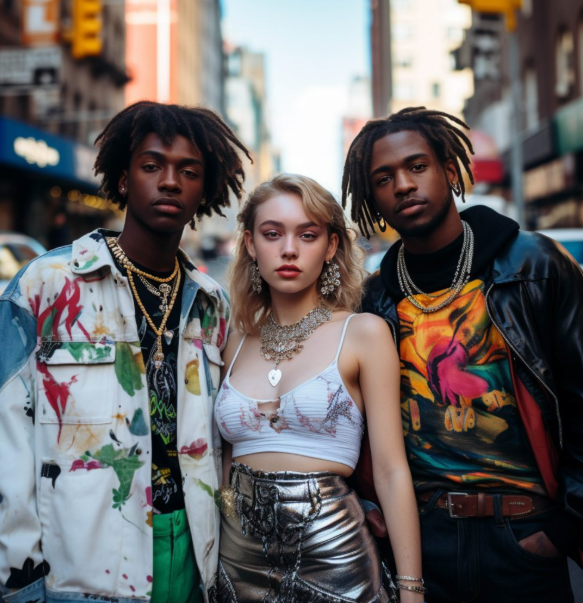Exploring Streetwear Culture: Its Impact on Fashion and Society

Streetwear has become more than just a trend – it’s a global cultural movement. This dynamic style, which began in the streets, has evolved to represent self-expression, creativity, and rebellion. Its roots can be traced back to the late ’70s and early ’80s, when skateboarding, hip-hop, and graffiti merged to create a unique form of fashion. Today, streetwear is everywhere, from the bustling streets of Mumbai and Delhi to the most iconic runways around the world. So, what exactly is streetwear culture, and why does it continue to influence fashion and society?
What is Streetwear Culture?
At its core, streetwear culture is about more than just clothing. It embodies a lifestyle that merges fashion with personal identity. This style is deeply tied to urban life, with elements of rebellion, freedom, and creativity woven into every piece. From oversized T-shirts to hoodies, sneakers, and graphic prints, streetwear speaks volumes about individuality. It’s not just about looking good; it’s about making a statement. Over time, this culture has spread globally, absorbing elements from different subcultures and merging them with local fashion influences, including in India.
The Origins of Streetwear Culture
Streetwear’s origin is rooted in California’s surf and skate scene, where comfort and functionality were key. Surfers and skateboarders needed practical, durable clothing that allowed freedom of movement. The earliest brands, such as Stüssy and Vans, were born out of this need for functional fashion.
In New York, the influence of hip-hop was also significant. Iconic looks like baggy pants, baseball caps, and heavy gold chains became staples of hip-hop fashion. The graffiti artists of the time also began translating their street art into wearable graphics, turning clothing into an extension of their personal expression. These various influences came together to form the streetwear culture we know today.
Streetwear Goes Global
What started on the streets of California and New York soon spread worldwide. Brands like Supreme, Off-White, and A Bathing Ape (BAPE) took streetwear global, blending their local street styles with international flair. Japan’s Harajuku district became a hotspot for street fashion, mixing bold colors and unique designs to create a global fashion phenomenon.
In India, streetwear culture has exploded in cities like Mumbai, Delhi, and Bangalore. Young people, especially Gen Z, have embraced this style for its creativity, freedom, and disregard for traditional fashion rules. Local brands like Six5Six Street, Almost Gods, and Jaywalking are leading the charge, fusing global streetwear trends with Indian cultural influences.
Why Streetwear Matters
Streetwear is more than just a passing fashion trend – it’s a movement that gives voice to self-expression. It challenges conventional fashion norms and allows individuals to define their own style. There are no strict rules about what can or can’t be worn together, making it an open playground for creativity.
Streetwear also serves as a platform for social commentary. Many streetwear brands use their designs to raise awareness about important social issues, such as gender equality, mental health, and climate change. Through these designs, streetwear becomes a form of protest and a way to engage with society on a deeper level.
The Connection Between Streetwear and Pop Culture
Celebrities and influencers have played a major role in the rise of streetwear culture. Rappers like Travis Scott and actors like Ranveer Singh have helped bring streetwear into the mainstream, making it the go-to style for young people worldwide. With collaborations between streetwear brands and luxury fashion houses, streetwear has cemented its place as a cultural force.
In India, social media platforms like Instagram and YouTube have been pivotal in spreading streetwear culture. Influencers showcase their oversized T-shirts, graphic designs, and limited-edition sneaker collections, helping to elevate the streetwear aesthetic.
Streetwear vs. Fast Fashion
Unlike fast fashion, which focuses on mass production and cheap, disposable clothing, streetwear is all about exclusivity and personal expression. Many streetwear releases are limited edition, making them highly sought after. The scarcity of these items adds to their value and status, creating a culture around “drops” and special releases.
Streetwear also encourages consumers to buy clothing that speaks to their personal identity. It’s less about following trends and more about finding pieces that reflect who you are. This is a stark contrast to the disposable nature of fast fashion, where items are produced in bulk and sold at low prices without much thought for individual style.
The Community Aspect of Streetwear
Streetwear is not just about clothes – it’s about community. Whether it’s waiting in line for the latest sneaker drop or joining an online group to share styling tips, the streetwear community is strong. Events like Sneaker Fest and Streetwear Pop-Ups in India provide a space for enthusiasts to connect, celebrate their shared love for street culture, and show off their latest finds.
In India, streetwear is also a way for young people to reconnect with their heritage. Many local streetwear brands are incorporating Indian cultural elements, such as Hindi typography, street art-inspired designs, and traditional motifs, into their clothing. This fusion of global streetwear trends with Indian culture is helping to create a distinct, Indian version of streetwear.
Sustainability in Streetwear
As environmental concerns grow, sustainability has become an important conversation within the streetwear community. Many streetwear brands are now using eco-friendly materials and adopting ethical production practices. In India, young creators are embracing the DIY culture by upcycling vintage clothing and modifying garments to give them a fresh, unique look. This approach not only promotes sustainability but also encourages individual creativity.
Streetwear in 2024 and Beyond
Looking ahead, streetwear is showing no signs of slowing down. The trend has expanded into the digital realm with virtual fashion, NFTs, and digital streetwear items appearing in gaming platforms and the metaverse. These digital products allow individuals to express themselves through avatars, bringing streetwear to a new virtual frontier.
In India, the fusion of streetwear with traditional ethnic designs is set to grow. Expect to see more handwoven fabrics and local cultural motifs incorporated into streetwear collections, as this trend continues to evolve and embrace new voices in fashion.
Conclusion
Streetwear culture is more than just a fashion trend – it’s a movement that represents individuality, creativity, and rebellion. From its roots in skateboarding, hip-hop, and graffiti, to its global expansion, streetwear has become a symbol of self-expression. In India, the rise of streetwear is a reflection of the country’s young, dynamic generation who are eager to make their mark on the world. As this culture continues to grow, it will undoubtedly shape the future of fashion and personal expression.





